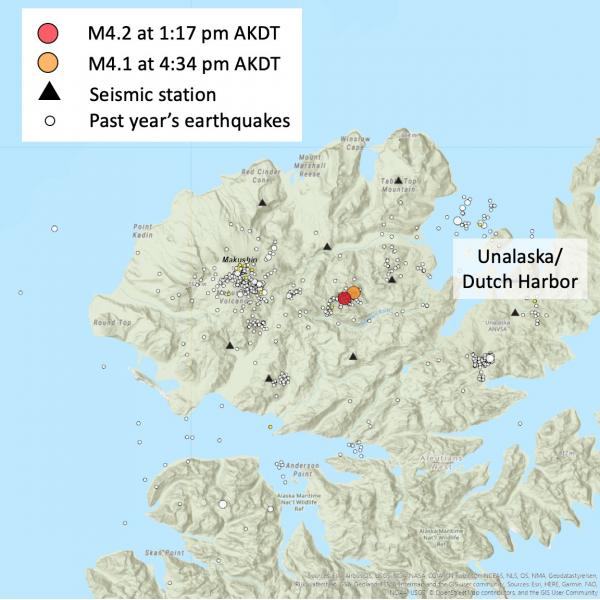
Figure of seismic network and recent larger earthquakes at Makushin Volcano. Seismic stations marked with black triangles. The location of the two larger earthquakes located June 15, 2020 are shown (red and orange circles). Earthquakes located within the past 12 months are shown as white circles. The location of the community of Unalaska/Dutch Harbor is also shown. Figure by Matt Haney, USGS/AVO.
Volcano(es):
Photographer: Haney, Matthew
URL: avo.alaska.edu/image/view/159461
Credit: Image courtesy of AVO/USGS.
Use Restriction: Please cite the photographer and the Alaska Volcano Observatory / U.S. Geological Survey when using this image.
Full Resolution.
Makushin 2020/6
From Orr and others, 2024: "Seismic activity near Makushin Volcano increased beginning in the summer of 2020. An earthquake swarm kicked off on June 15 at 21:16 UTC (13:16 AKDT) with an earthquake of local magnitude (ML) 4.2 that was located ~12 km [7.5 mi] east-southeast of the volcano. This event was followed by hundreds of aftershocks in the same general area with several of ML 3–4, including a ML 4.1 earthquake on June 16 at 00:34 UTC (June 15 at 16:34 AKDT). The two ML 4 earthquakes and many of their aftershocks were felt strongly by residents of the City of Unalaska. The earthquake depths during this period ranged from 5 to 14 km.
Elevated seismicity near the volcano continued for the remainder of 2020, although the events gradually decreased in frequency over time. No other signs of unrest or surface deformation were observed at Makushin Volcano in remote sensing data, gas measurements, GNSS data, InSAR data, or webcam images. However, several deep long-period (LP) earthquakes (depths greater than 9 km [5.6 mi]) were recorded beneath the volcano’s summit prior to and during the June swarm. These LP events may represent magma movement in the lower crust, although such earthquakes are not unusual for Makushin Volcano.
"At the time of the swarm, AVO was uncertain whether the earthquake sources were related to tectonic or volcanic stresses. Therefore, on June 16, a seismic watch schedule was implemented, and the Aviation Color Code and Volcano Alert Level were raised to YELLOW and ADVISORY. On September 8, after seismic activity had returned to background levels and no other signs of volcanic unrest were observed, the Aviation Color Code and Volcano Alert Level were lowered back to GREEN and NORMAL.
"By analyzing the fault plane solutions of the earthquakes in the swarm, Lanza and others (2022) found that many of the larger earthquakes had P-axes oriented consistently with the regional maximum compression, but most of the smaller earthquakes had P-axes perpendicular to the regional maximum compression. On the basis of these findings, they concluded that the triggering mechanism of the earthquakes was most likely a combination of stresses from tectonic and magmatic sources along existing fault lines."